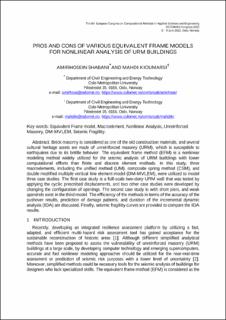| dc.contributor.author | Shabani, Amirhosein | |
| dc.contributor.author | Kioumarsi, Mahdi | |
| dc.date.accessioned | 2023-02-20T09:33:08Z | |
| dc.date.available | 2023-02-20T09:33:08Z | |
| dc.date.created | 2023-02-09T12:02:03Z | |
| dc.date.issued | 2022 | |
| dc.identifier.isbn | 9788412322286 | |
| dc.identifier.uri | https://hdl.handle.net/11250/3052223 | |
| dc.description.abstract | Brick masonry is considered as one of the old construction materials, and several cultural heritage assets are made of unreinforced masonry (URM), which is susceptible to earthquakes due to its brittle behavior. The equivalent frame method (EFM) is a nonlinear modeling method widely utilized for the seismic analysis of URM buildings with lower computational efforts than finite and discrete element methods. In this study, three macroelements, including the unified method (UM), composite spring method (CSM), and double modified multiple vertical line element model (DM-MVLEM), were utilized to model three case studies. The first case study is a full-scale two-story URM wall that was tested by applying the cyclic prescribed displacements, and two other case studies were developed by changing the configuration of openings. The second case study is with short piers, and weak spandrels exist in the third model. The efficiency of the methods in terms of the accuracy of the pushover results, prediction of damage patterns, and duration of the incremental dynamic analysis (IDA) are discussed. Finally, seismic fragility curves are provided to compare the IDA results. | en_US |
| dc.language.iso | eng | en_US |
| dc.publisher | ECCOMAS | en_US |
| dc.relation.ispartof | 8th European Congress on Computational Methods in Applied Sciences and Engineering (ECCOMAS Congress 2022) | |
| dc.relation.ispartofseries | ECCOMAS Congress;8th European Congress on Computational Methods in Applied Sciences and Engineering | |
| dc.relation.uri | https://www.scipedia.com/public/Shabani_Kioumarsi_2022a | |
| dc.rights | Navngivelse-Ikkekommersiell-DelPåSammeVilkår 4.0 Internasjonal | * |
| dc.rights.uri | http://creativecommons.org/licenses/by-nc-sa/4.0/deed.no | * |
| dc.title | Pros and cons of various equivalent frame models for nonlinear analysis of URM buildings | en_US |
| dc.type | Conference object | en_US |
| dc.description.version | publishedVersion | en_US |
| cristin.ispublished | true | |
| cristin.fulltext | original | |
| cristin.qualitycode | 1 | |
| dc.identifier.doi | https://doi.org/10.23967/eccomas.2022.226 | |
| dc.identifier.cristin | 2124476 | |
| dc.source.volume | 8 | en_US |
| dc.source.issue | 8 | en_US |
| dc.source.pagenumber | 1-12 | en_US |
| dc.relation.project | EU/HYPERION_No 821054 | en_US |

